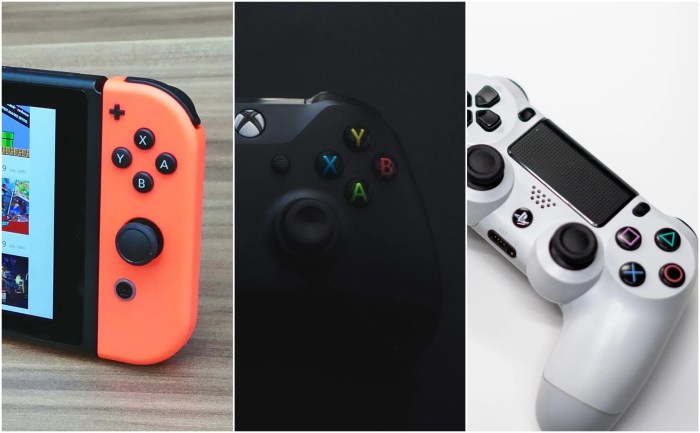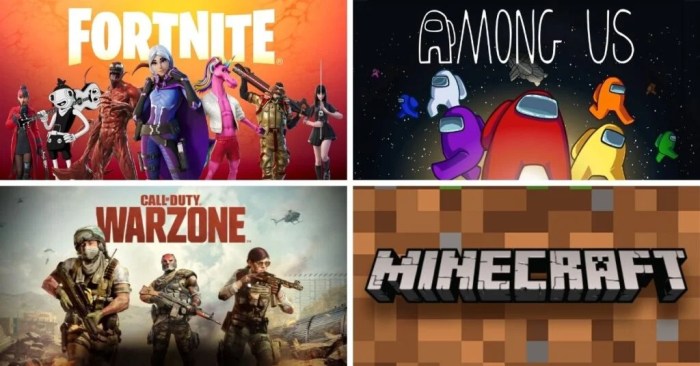Cross-Platform Play is totally blowing up the gaming world, connecting players across different consoles and PCs like never before. It’s awesome for expanding your friend group and finding more competition, but it also throws some serious curveballs at developers who have to figure out how to make sure everyone’s playing fair. This deep dive explores the tech, the triumphs, and the total headaches of making cross-platform gaming a reality.
From the technical hurdles of syncing different systems to the design challenges of balancing gameplay across wildly different controllers and hardware, cross-platform play isn’t just about smashing buttons; it’s about creating a unified gaming experience that’s fair, fun, and accessible to everyone. We’ll look at some killer examples of games that nailed it—and some epic fails to learn from.
Get ready to geek out!
Benefits and Drawbacks of Cross-Platform Play

Cross-platform play, the ability for players on different gaming platforms (like Xbox, PlayStation, PC, and Switch) to play together, has dramatically reshaped the gaming landscape. While offering significant advantages for both players and developers, it also presents some notable challenges that need careful consideration. This section will delve into the pros and cons, examining the impact on the gaming community.
Advantages for Players
The most immediate benefit for players is a significantly expanded player base. Imagine a game with a small community on your console; cross-platform play suddenly opens it up to potentially millions more players on other platforms. This leads to shorter queue times for matchmaking, increased chances of finding a game, and a more diverse and dynamic gaming experience. Furthermore, the larger player pool fosters increased competition.
Players are exposed to a wider range of skill levels and play styles, pushing them to improve and adapt their strategies. This increased competition can be incredibly motivating and enhance the overall enjoyment of the game.
Advantages for Game Developers
For game developers, cross-platform play translates to a wider market reach, potentially boosting sales and revenue significantly. Reaching players across multiple platforms eliminates the limitations of a single console’s user base. Moreover, it can lead to cost savings. Instead of developing separate versions of the game for each platform, developers can focus on a single, cross-platform compatible version, reducing development time and expenses.
This allows for quicker release cycles and the possibility of reinvesting resources into other aspects of the game, like enhanced graphics or new content.
Disadvantages for Players
Despite the numerous advantages, cross-platform play isn’t without its drawbacks. One major concern is balancing issues. Different platforms may have varying input methods (controller vs. keyboard and mouse), leading to potential imbalances in gameplay. A player using a keyboard and mouse on PC might have a significant advantage over a controller user on a console, creating frustration and an uneven playing field.
This disparity can make the game feel unfair, impacting the overall enjoyment for some players. Another challenge is the potential for cheating to become more prevalent. With a larger player base comes a higher likelihood of encountering cheaters, potentially ruining the experience for legitimate players.
Examples of Cross-Platform Play’s Impact
The impact of cross-platform play is readily observable in the gaming community. Games like
- Fortnite* and
- Rocket League* saw a massive surge in popularity and player engagement after implementing cross-platform play. This resulted in more vibrant online communities and a longer lifespan for these titles. However, the integration hasn’t been seamless for every game. Some titles have struggled with balancing issues, leading to player complaints and adjustments needing to be made to gameplay mechanics.The experience highlights the importance of careful planning and implementation to ensure a fair and enjoyable experience for all players. The success or failure of cross-platform play implementation often hinges on the developer’s ability to address these potential challenges proactively.
Impact on Game Design and Balancing

Cross-platform play introduces a fascinating set of challenges and opportunities for game designers. The ability to seamlessly integrate players from different platforms—PC, consoles, mobile—requires careful consideration of control schemes, user interfaces, and, most critically, gameplay balancing. Ignoring these factors can lead to a frustrating and unfair experience for a significant portion of the player base.The core issue lies in the inherent differences between input methods and hardware capabilities.
A player using a mouse and keyboard on a PC will generally have a significant advantage over a player using a controller on a console, particularly in games requiring precise aiming or quick reflexes. This disparity necessitates thoughtful design choices to ensure a level playing field, or at least minimize the impact of these differences.
Control Scheme Standardization and UI Adaptation
Implementing cross-platform play often requires compromises in control schemes. Games might need to offer multiple control options to accommodate different input devices. For example, a game might allow players to customize button mappings on controllers to better suit their preferences, or offer keyboard and mouse support on consoles. Similarly, user interfaces need to be adaptable to different screen sizes and resolutions, ensuring readability and usability across all platforms.
ConsiderFortnite*, which successfully integrates players across various platforms by offering consistent core gameplay while allowing for customization of control schemes. The UI adapts smoothly to different screen sizes, ensuring consistent experience whether you are playing on a mobile phone, a Switch, or a high-end PC.
Balancing Gameplay Across Platforms, Cross-Platform Play
Achieving balance in cross-platform environments is a complex undertaking. The differences in input precision, response times, and even field of view can significantly impact gameplay. Games often need to adjust aspects like character movement speeds, weapon damage, or aiming assistance to compensate for these disparities. For example, a game might reduce the aim assist for controller users on PC to prevent them from having an unfair advantage over keyboard and mouse users.
Conversely, a game might slightly increase the movement speed of controller users to compensate for the slower reaction times often associated with that input method.
Call of Duty
Modern Warfare* provides a real-world example of attempts at balancing. While it faced criticism for not perfectly addressing the disparity between controller and keyboard/mouse players, it consistently made adjustments to aim assist and other mechanics based on player feedback and data analysis.
Strategies for Maintaining Fair Competition
Several strategies can help maintain fair competition across different input methods and hardware. Skill-based matchmaking (SBMM) is a common approach, grouping players with similar skill levels together regardless of their platform. This reduces the impact of hardware differences by ensuring players are competing against others of similar ability. Another strategy is to introduce input-specific balancing adjustments. This might involve tweaking certain game mechanics, like aiming sensitivity or movement speed, to compensate for the advantages or disadvantages of specific input devices.
Furthermore, transparent communication with the player base about balancing decisions and adjustments is crucial to build trust and address concerns. Regular updates and patches can address imbalances as they arise, ensuring the game remains fair and enjoyable for all players. The success ofRocket League*, a game with robust cross-platform play, showcases the importance of ongoing adjustments based on data and community feedback in maintaining balance.
The developers continuously tweak gameplay elements to ensure that skill remains the primary determinant of success, irrespective of the platform.
Case Studies

Cross-platform play has become a significant feature in modern gaming, impacting player bases and game design in profound ways. Examining specific examples allows us to understand both the triumphs and challenges associated with implementing this functionality. The following case studies illustrate the diverse experiences and outcomes of cross-platform play integration.
Fortnite’s Cross-Platform Success
Fortnite’s implementation of cross-platform play is often cited as a monumental success. From the outset, Epic Games prioritized seamless integration across PC, consoles, and mobile devices. This decision dramatically expanded the player pool, leading to increased player interaction and a more vibrant online community. Technically, achieving this level of cross-platform compatibility required significant effort in addressing network latency issues and input device differences (mouse and keyboard vs.
controllers). They addressed these challenges by implementing robust server-side solutions and carefully balancing gameplay mechanics to ensure fair competition across different input methods. The success of Fortnite’s cross-platform play is evident in its sustained popularity and massive player base, which has remained consistently high across various platforms.
Minecraft’s Cross-Platform Journey
Minecraft’s cross-platform play journey highlights the iterative nature of such implementations. Initial efforts faced difficulties in synchronizing gameplay across vastly different hardware and software platforms. Mojang Studios gradually improved cross-platform functionality, eventually achieving relatively seamless play between various versions of the game. However, some minor inconsistencies in gameplay and performance remain depending on the platform. Despite these challenges, cross-platform play in Minecraft significantly enhanced the player experience, particularly for communities that spanned multiple platforms.
The increased accessibility fostered a larger, more interconnected player base, boosting the game’s longevity and reputation.
Rocket League’s Smooth Integration
Psyonix’s Rocket League provides another compelling example of successful cross-platform integration. The game’s relatively simple mechanics and consistent gameplay across different platforms facilitated a relatively straightforward implementation of cross-platform play. The developers focused on ensuring fair matchmaking and balancing, accounting for differences in input devices. The result has been a thriving cross-platform community with little reported disruption or negative impact on gameplay experience.
Rocket League’s success underscores the importance of careful design and planning in the implementation of cross-platform features.
Call of Duty: Modern Warfare’s Complexities
Call of Duty: Modern Warfare’s cross-platform implementation presented unique challenges due to the game’s competitive nature and the significant skill disparities potentially introduced by different input methods. While the game achieved cross-play functionality, controversies arose surrounding the perceived advantage of PC players using mouse and keyboard over console players using controllers. Activision attempted to address these concerns through matchmaking adjustments and skill-based settings, but the debate continues.
This case study demonstrates that even with successful technical implementation, the social and competitive aspects of cross-platform play require careful consideration and ongoing adjustments.
| Game | Technical Challenges | Impact on Player Base | Long-Term Success |
|---|---|---|---|
| Fortnite | Network latency, input device differences | Massive increase, vibrant community | High, sustained popularity |
| Minecraft | Synchronization across different platforms | Increased accessibility, larger community | High, ongoing updates and expansion |
| Rocket League | Fair matchmaking, input device balancing | Thriving cross-platform community | High, continued popularity and esports presence |
| Call of Duty: Modern Warfare | Input device disparity, competitive balance | Increased player base, but with ongoing controversies | Moderate, ongoing updates and new releases |
Clarifying Questions: Cross-Platform Play
What are the biggest security concerns with cross-platform play?
Security is a major concern. Different platforms have varying security protocols, making it crucial to implement robust anti-cheat measures and secure communication channels to prevent hacking and exploits.
How does cross-platform play affect input methods?
It creates a big challenge! A mouse and keyboard provide a very different level of precision than a controller. Games need to account for this difference to maintain fair competition, often through skill-based matchmaking or controller customization options.
Does cross-platform play always mean cross-progression?
Nope! While some games allow you to carry your progress across platforms, many don’t. Cross-platform play just means you can play
-with* others on different systems, not necessarily
-carry over* your progress.
What’s the deal with microtransactions and cross-platform play?
It’s a complex issue. Games need to ensure that purchases and in-game items are consistent and accessible across all platforms, preventing any imbalances or unfair advantages related to microtransactions.